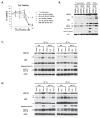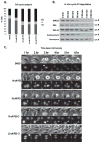A modified HSP70 inhibitor shows broad activity as an anticancer agent
- PMID: 23303345
- PMCID: PMC3606282
- DOI: 10.1158/1541-7786.MCR-12-0547-T
A modified HSP70 inhibitor shows broad activity as an anticancer agent
Abstract
The stress-induced HSP70 is an ATP-dependent molecular chaperone that plays a key role in refolding misfolded proteins and promoting cell survival following stress. HSP70 is marginally expressed in nontransformed cells, but is greatly overexpressed in tumor cells. Silencing HSP70 is uniformly cytotoxic to tumor but not normal cells; therefore, there has been great interest in the development of HSP70 inhibitors for cancer therapy. Here, we report that the HSP70 inhibitor 2-phenylethynesulfonamide (PES) binds to the substrate-binding domain of HSP70 and requires the C-terminal helical "lid" of this protein (amino acids 573-616) to bind. Using molecular modeling and in silico docking, we have identified a candidate binding site for PES in this region of HSP70, and we identify point mutants that fail to interact with PES. A preliminary structure-activity relationship analysis has revealed a derivative of PES, 2-(3-chlorophenyl) ethynesulfonamide (PES-Cl), which shows increased cytotoxicity and ability to inhibit autophagy, along with significantly improved ability to extend the life of mice with pre-B-cell lymphoma, compared with the parent compound (P = 0.015). Interestingly, we also show that these HSP70 inhibitors impair the activity of the anaphase promoting complex/cyclosome (APC/C) in cell-free extracts, and induce G2-M arrest and genomic instability in cancer cells. PES-Cl is thus a promising new anticancer compound with several notable mechanisms of action.
Conflict of interest statement
The authors declare there are no conflicts of interest
Figures






Similar articles
-
Comparison of the activity of three different HSP70 inhibitors on apoptosis, cell cycle arrest, autophagy inhibition, and HSP90 inhibition.Cancer Biol Ther. 2014 Feb;15(2):194-9. doi: 10.4161/cbt.26720. Epub 2013 Nov 1. Cancer Biol Ther. 2014. PMID: 24100579 Free PMC article.
-
Molecular chaperone function of stress inducible Hsp70 is critical for intracellular multiplication of Toxoplasma gondii.Biochim Biophys Acta Mol Cell Res. 2021 Feb;1868(2):118898. doi: 10.1016/j.bbamcr.2020.118898. Epub 2020 Nov 4. Biochim Biophys Acta Mol Cell Res. 2021. PMID: 33157166
-
The Hsp70 inhibitor 2-phenylethynesulfonamide inhibits replication and carcinogenicity of Epstein-Barr virus by inhibiting the molecular chaperone function of Hsp70.Cell Death Dis. 2018 Jun 29;9(7):734. doi: 10.1038/s41419-018-0779-3. Cell Death Dis. 2018. PMID: 29959331 Free PMC article.
-
Inhibitors of HSP90 in melanoma.Apoptosis. 2020 Feb;25(1-2):12-28. doi: 10.1007/s10495-019-01577-1. Apoptosis. 2020. PMID: 31659567 Free PMC article. Review.
-
Hsp90 interaction with clients.Trends Biochem Sci. 2015 Feb;40(2):117-25. doi: 10.1016/j.tibs.2014.12.002. Epub 2015 Jan 9. Trends Biochem Sci. 2015. PMID: 25579468 Review.
Cited by
-
PES inhibits human-inducible Hsp70 by covalent targeting of cysteine residues in the substrate-binding domain.J Biol Chem. 2021 Jan-Jun;296:100210. doi: 10.1074/jbc.RA120.015440. Epub 2020 Dec 24. J Biol Chem. 2021. PMID: 33835030 Free PMC article.
-
Pifithrin-μ, an inhibitor of heat-shock protein 70, can increase the antitumor effects of hyperthermia against human prostate cancer cells.PLoS One. 2013 Nov 14;8(11):e78772. doi: 10.1371/journal.pone.0078772. eCollection 2013. PLoS One. 2013. PMID: 24244355 Free PMC article.
-
Heat shock factor 1 confers resistance to Hsp90 inhibitors through p62/SQSTM1 expression and promotion of autophagic flux.Biochem Pharmacol. 2014 Feb 1;87(3):445-55. doi: 10.1016/j.bcp.2013.11.014. Epub 2013 Nov 28. Biochem Pharmacol. 2014. PMID: 24291777 Free PMC article.
-
Hsc70/Stub1 promotes the removal of individual oxidatively stressed peroxisomes.Nat Commun. 2020 Oct 19;11(1):5267. doi: 10.1038/s41467-020-18942-3. Nat Commun. 2020. PMID: 33077711 Free PMC article.
-
The Structural Diversity of Marine Microbial Secondary Metabolites Based on Co-Culture Strategy: 2009-2019.Mar Drugs. 2020 Aug 27;18(9):449. doi: 10.3390/md18090449. Mar Drugs. 2020. PMID: 32867339 Free PMC article. Review.
References
-
- Daugaard M, Rohde M, Jäättelä M. The heat shock protein 70 family: Highly homologous proteins with overlapping and distinct functions. FEBS Lett. 2007;581:3702–10. - PubMed
-
- Powers MV, Jones K, Barillari C, Westwood I, van Montfort RL, Workman P. Targeting HSP70: the second potentially druggable heat shock protein and molecular chaperone? Cell Cycle. 2010;9:1542–50. - PubMed
-
- Schmitt E, Maingret L, Puig PE, Rerole AL, Ghiringhelli F, Hammann A, Solary E, Kroemer G, Garrido C. Heat shock protein 70 neutralization exerts potent antitumor effects in animal models of colon cancer and melanoma. Cancer Res. 2006;66:4191–7. - PubMed
Publication types
MeSH terms
Substances
Grants and funding
LinkOut - more resources
Full Text Sources
Other Literature Sources
Molecular Biology Databases

